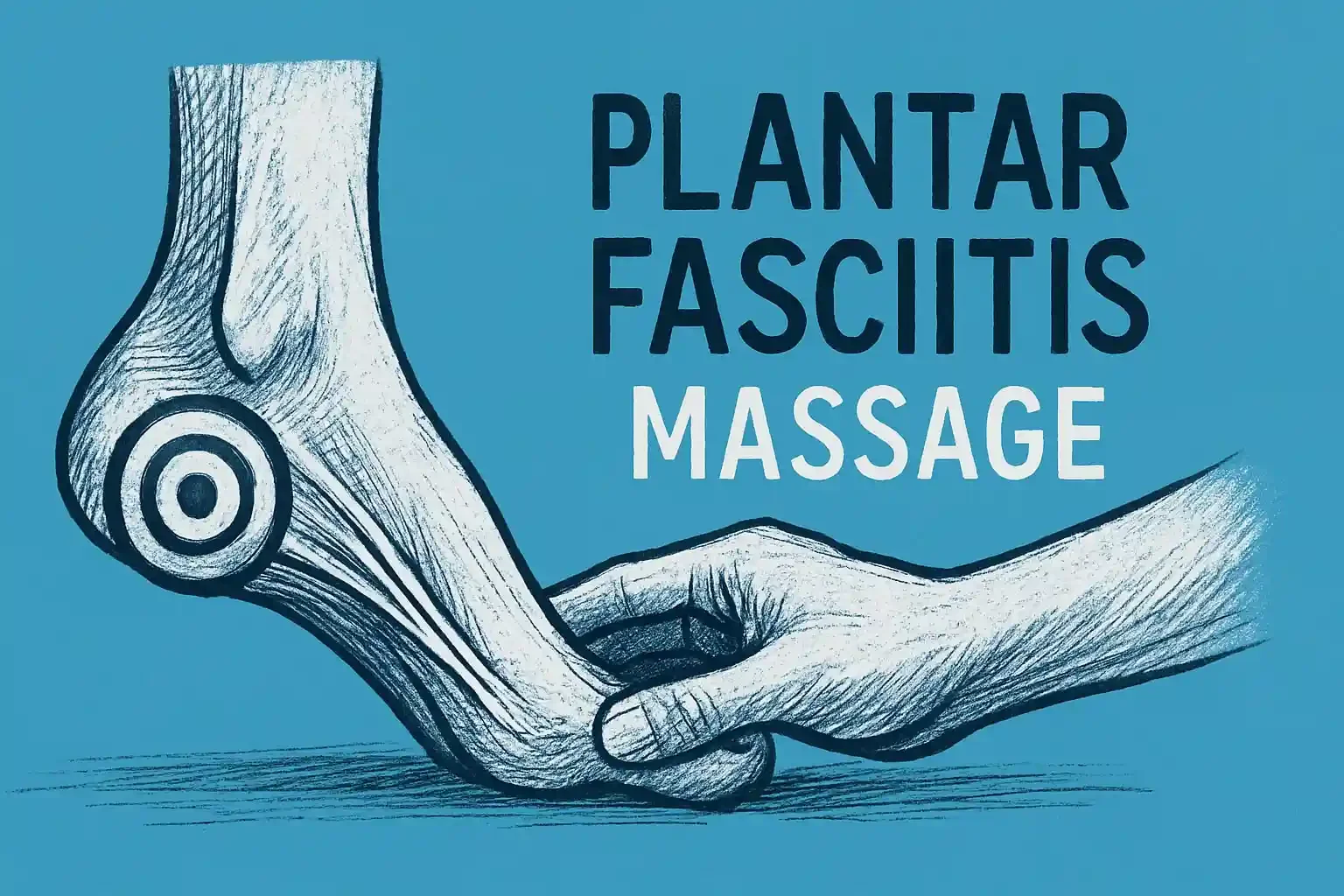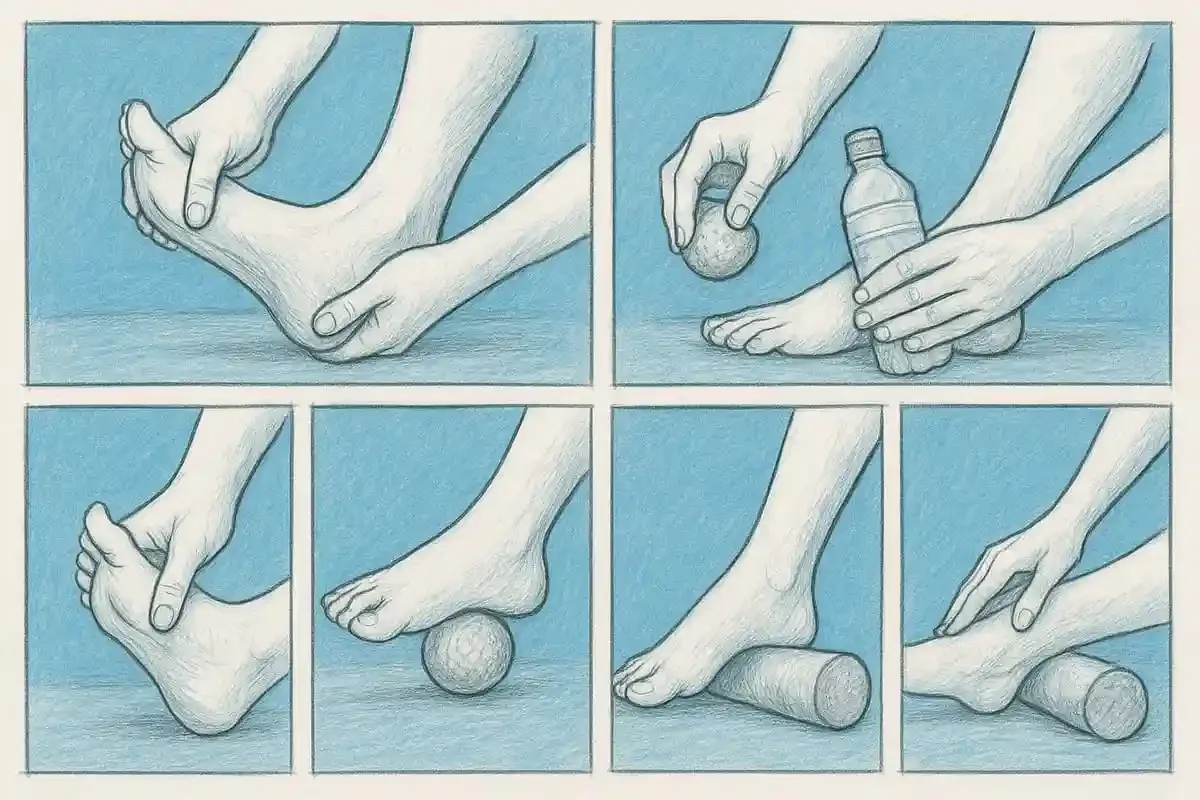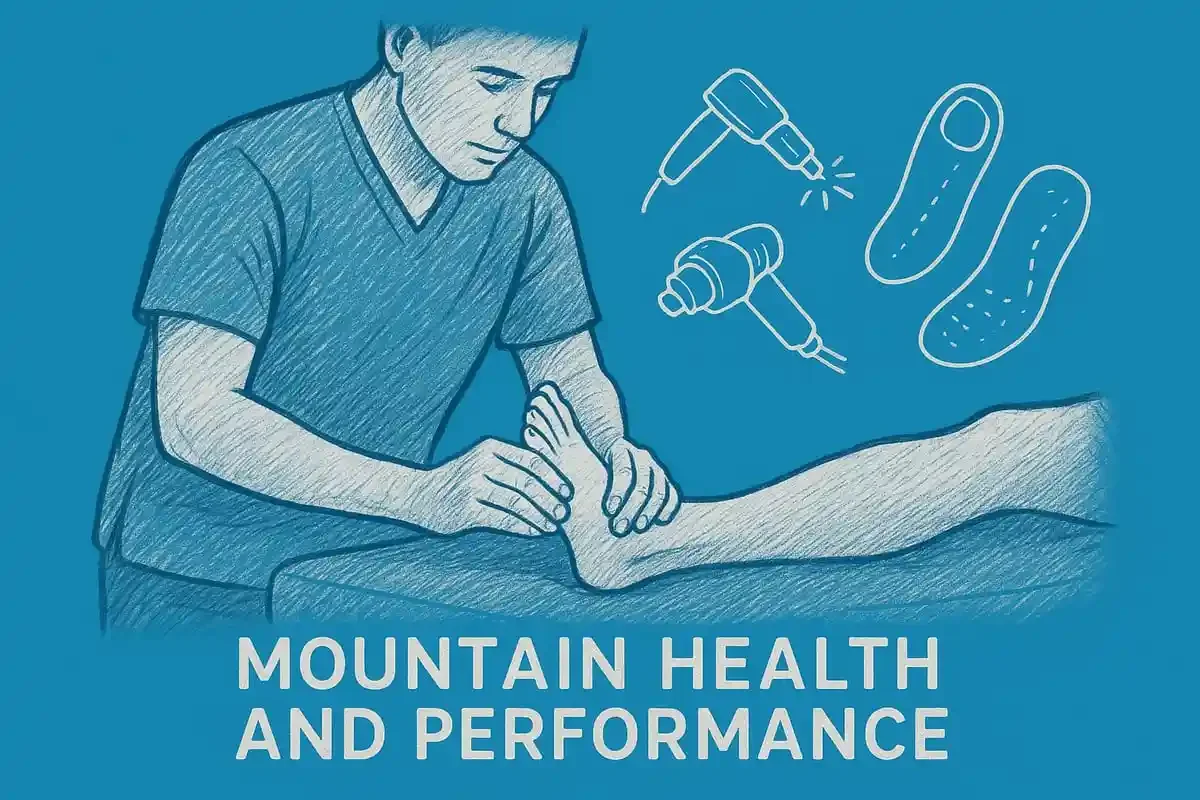7 Best Plantar Fasciitis Massage Techniques for Relief
Heel and arch pain can sideline even the most active people, making simple steps feel impossible. Plantar fasciitis is a common condition that inflames the thick band of tissue on the bottom of your foot, causing sharp discomfort for millions worldwide.
Plantar fasciitis massage offers a simple, effective way to ease pain and jump-start healing, whether you are an athlete or someone who spends long hours on your feet. It is accessible, affordable, and backed by experts.
This article reveals the 7 best plantar fasciitis massage techniques, blending trusted strategies with the newest self-care insights. Get ready to discover practical, hands-on methods, tool-based options, and professional tips to help you move pain-free again.
Understanding Plantar Fasciitis: Causes, Symptoms, and Why Massage Helps
Plantar fasciitis is one of the most common causes of heel and arch pain, especially for active people and those on their feet all day. It occurs when the plantar fascia, a thick band of tissue running along the bottom of your foot, becomes irritated and inflamed. This leads to discomfort that can interfere with daily life and athletic performance.
What Causes Plantar Fasciitis?
Several factors can trigger or worsen plantar fasciitis, including:
Overuse from running or walking long distances
Wearing shoes with poor support or thin soles
Spending hours standing on hard surfaces
Sudden increases in activity level
Having flat feet or high arches
These triggers put extra strain on the plantar fascia, making it more prone to micro-tears and inflammation.
Recognizing the Symptoms
Key symptoms of plantar fasciitis include:
Sharp, stabbing pain in the heel, often worse when you take your first steps in the morning
Tenderness or swelling along the arch or bottom of the foot
Discomfort that may ease with movement but returns after rest
About 10% of people will experience plantar fasciitis at some point in their lives.
Why Is Plantar Fasciitis Massage Effective?
Plantar fasciitis massage is an accessible approach for managing symptoms and promoting healing. Massage stimulates blood flow to the affected area, helps break up adhesions, and gently stretches the fascia. This combination reduces inflammation and encourages tissue repair.
Clinical studies show that plantar fasciitis massage, when combined with stretching, can significantly reduce pain and improve foot function. For instance, a 2013 study referenced by Healthline found that consistent massage therapy helped participants regain mobility and decrease discomfort.
The Value of Professional and Collaborative Care
While self-massage is powerful, working with experienced therapists can take your recovery further. The massage therapists at Mountain Health and Performance are specially trained to assess your unique needs and deliver targeted techniques. Their collaborative approach means you also benefit from other advanced therapies, such as laser therapy, shockwave therapy, and custom orthotics, all of which support faster and more comprehensive relief.
For more insight on how expert therapists address plantar fasciitis and coordinate care, explore North Vancouver Registered Massage Therapy.
Massage as Part of a Holistic Solution
It is important to remember that plantar fasciitis massage works best when combined with other treatments like stretching, proper footwear, and rest. Runners and people with flat feet, for example, often notice the greatest improvements when they use massage alongside these strategies. By making massage part of your daily routine, you can take proactive steps toward lasting relief and healthier feet.
When and How to Use Plantar Fasciitis Massage Safely
Using plantar fasciitis massage at the right times and in the right way can make a big difference in your comfort and recovery. Knowing when to massage, how to do it safely, and when to get help from specialists is essential for long-term relief. Below, you will find practical guidance to get the most from your plantar fasciitis massage routine.
The Best Times to Massage for Maximum Relief
Timing your plantar fasciitis massage is just as important as your technique. Many people feel the worst heel pain first thing in the morning. Massaging your feet before you stand up can help reduce those sharp pains. Similarly, a quick session after exercise or before bed can ease soreness and prepare your feet for rest.
Warming up your feet first by soaking them in warm water or doing gentle ankle circles can make plantar fasciitis massage more effective. For example, runners often massage their arches after a workout to prevent stiffness. Try keeping a massage ball by your bedside or under your desk so you can use it when you need it most.
Safety Tips and Precautions
To get the most benefit from plantar fasciitis massage, always start with gentle pressure. Increase it gradually as your comfort allows. Using a moisturizer or massage oil helps your hands glide smoothly and prevents skin irritation.
Never massage over open wounds, severe swelling, or bruises. If you notice sharp pain, redness, or worsening symptoms, stop immediately. It is best to avoid aggressive massage during flare-ups, as this can aggravate inflammation. Following these safety tips ensures your plantar fasciitis massage is both safe and effective. For more on safe manual techniques, see this manual therapy interventions for plantar fasciitis study.
How Often and How Long to Massage
Consistency is key for plantar fasciitis massage. Experts recommend several short sessions each day, about 1 to 2 minutes per technique, over at least six weeks. This routine helps build up the benefits without overworking the tissue.
Short, frequent massages can be more effective than occasional long sessions. Try combining your plantar fasciitis massage with stretching and periods of rest for the best results. Keep a regular schedule, and listen to your body as you adjust the intensity.
When to Seek Professional Help
If your plantar fasciitis massage routine does not bring relief after six weeks, or if pain becomes severe and affects your ability to walk, it is time to consult a professional. Sudden swelling, redness, or inability to bear weight are signs you should get help right away.
At Mountain Health and Performance, their massage therapists can provide expert assessment and hands-on care. Taking a holistic approach to care, the often work calves, hamstrings, glutes and low back in plantar fasciitis patients. They also work closely with other specialists to offer laser therapy, shockwave therapy, and custom orthotics, giving you a comprehensive approach to plantar fasciitis relief.
7 Best Plantar Fasciitis Massage Techniques for Relief 2025
Plantar fasciitis massage can make a world of difference if you are dealing with chronic heel or arch pain. The right massage techniques not only target pain but also help restore function, flexibility, and comfort. Below, you will find a breakdown of the seven best plantar fasciitis massage approaches for 2025, each tailored to support healing and daily relief.
1. Heel-of-Hand Massage
The heel-of-hand massage is a cornerstone for anyone seeking plantar fasciitis massage relief. Sit comfortably and use the broad part of your palm to apply gentle, sweeping pressure from your heel toward your toes.
Start with long, light strokes to warm up the area, then gradually increase pressure as your comfort grows. This technique loosens the fascia and boosts blood flow, encouraging healing.
Tip: Try using a softly clenched fist for deeper pressure if your tissue feels especially tight.
Many people find this method useful first thing in the morning before standing up. It is simple and can be done anywhere, making it a practical first step in your plantar fasciitis massage routine.
2. Thumb Pushes and Pulls
For targeted relief, thumb pushes and pulls work wonders in any plantar fasciitis massage session. Place both thumbs at the base of your heel and press firmly, gliding up toward the toes.
Repeat this motion, focusing on any sore or stiff spots along the arch. To add a stretch, position your thumbs in the center of your sole and gently pull outward, encouraging flexibility in the fascia.
Perform this technique for one to two minutes per foot, increasing pressure as comfort allows. Regular thumb pushes and pulls are shown to decrease pain and improve foot mobility, especially for those with persistent symptoms.
3. Ball Rolling Massage
Ball rolling massage is a favorite self-care option for plantar fasciitis massage. Take a tennis ball, lacrosse ball, or a specialized massage ball, and place it under your arch.
Slowly roll your foot back and forth, applying light to moderate pressure. You control the intensity, so adjust to your comfort level. This technique reaches deep into the fascia and is easy to fit into your daily schedule.
Keep a massage ball under your desk for quick relief during work or use it while watching TV. Ball size and firmness can be customized, making this a versatile addition to your plantar fasciitis massage arsenal.
4. Ice Bottle Massage
When inflammation flares, ice bottle massage delivers a soothing combination of cold therapy and plantar fasciitis massage. Freeze a water bottle or use a chilled can, then roll it under your foot for five to ten minutes.
The cold reduces swelling while the rolling motion massages the fascia, offering relief after activity or at the end of a long day. Many find this especially helpful in the morning before taking their first steps.
If you have poor circulation or are sensitive to cold, use caution and limit exposure. Ice bottle massage pairs well with other plantar fasciitis massage techniques for all-day comfort.
5. Toe Flex and Stretch Massage
Incorporating toe flex and stretch moves into your plantar fasciitis massage routine targets both the fascia and the toes. While massaging the foot, flex and point your toes, or gently pull and rotate each one to enhance mobility.
This approach helps relieve tightness in the forefoot and supports overall foot flexibility. Combine it with the heel-of-hand or thumb techniques for a comprehensive massage session.
Research shows that increasing foot and toe flexibility supports long-term recovery from plantar fasciitis. Make this a regular part of your routine for the best results.
6. Cross-Friction Massage
Cross-friction massage is especially effective for chronic cases of plantar fasciitis. Use your finger pads to massage across the width of the fascia, not along its length.
Avoid using lotion, so your skin moves with your fingers, targeting the deeper tissue layers. This technique helps break up adhesions and stimulates healing in stubborn cases.
It is best performed after warming up the foot and should be kept short, around one to two minutes. For more on the effectiveness of manual therapy, see this systematic review on manual therapy for plantar heel pain.
7. Calf Muscle Massage (Kneading, Pulling, Rolling)
Calf muscle massage is a crucial, yet often overlooked, aspect of plantar fasciitis massage. Tight calves can increase strain on the plantar fascia, so regular calf work is key.
Use both hands to knead the calf muscle, working from ankle to knee. Try clamping your hands around the calf and gently pulling the muscle forward, or use a foam roller to roll out tightness.
This technique is especially helpful for runners or people who spend long hours on their feet. Studies support the use of deep calf massage, in combination with stretching, to improve pain and function for plantar fasciitis sufferers.
The Role of Professional Massage Therapy in Plantar Fasciitis Relief
Professional plantar fasciitis massage can make a significant difference for those struggling with ongoing heel and arch pain. While self-massage is helpful, skilled hands often provide deeper and more targeted relief. At Mountain Health and Performance, the massage therapists bring advanced expertise to every session, using techniques that are both evidence-based and personalized.
How Registered Massage Therapists Can Help
Registered massage therapists at Mountain Health and Performance specialize in plantar fasciitis massage, delivering care that targets the fascia and surrounding muscles. They assess your gait, muscle imbalances, and unique symptoms, ensuring each treatment is tailored for maximum impact.
Using a blend of deep tissue, myofascial release, and trigger point work, RMTs help reduce inflammation and break up adhesions. For many patients, this professional approach brings more lasting results than home care alone. Therapists also educate you on self-massage techniques and home routines, empowering you to manage symptoms between visits.
Massage Therapy at Mountain Health and Performance
What sets Mountain Health and Performance apart is their collaborative approach to plantar fasciitis massage and overall foot health. The massage therapists work closely with chiropractors and rehabilitation professionals to create a comprehensive recovery plan.
Patients receive not only hands-on massage but also access to cutting-edge therapies like laser therapy and shockwave therapy. Both are proven to accelerate healing and reduce chronic pain. In addition, custom orthotics are available to address biomechanical issues that may contribute to plantar fasciitis.
This multidisciplinary method ensures that every aspect of plantar fasciitis is addressed. The clinic’s massage therapists coordinate care, adjust treatments as you progress, and offer direct communication with other providers. For those needing advanced techniques, you can learn more about Deep Tissue Massage Techniques that are often integrated into treatment plans.
With flexible scheduling, direct billing, and a convenient North Vancouver location, Mountain Health and Performance makes expert plantar fasciitis massage accessible and effective for long-term relief.
Combining Massage with Other Proven Plantar Fasciitis Treatments
Integrating plantar fasciitis massage into a broader care routine can accelerate healing and minimize flare-ups. The massage therapists at Mountain Health and Performance excel at blending hands-on therapy with evidence-based strategies, ensuring every patient gets a personalized, effective plan. Their collaborative approach with the chiropractic team connects massage with advanced services like laser therapy, shockwave therapy, and custom orthotics, gives you the best chance at lasting relief.
Stretching and Strengthening Exercises
Adding stretching and strengthening to your plantar fasciitis massage routine helps target the root of the problem. Calf stretches, towel stretches, and toe curls are proven to reduce tension and improve foot resilience. By pairing regular plantar fasciitis massage with daily exercises, you boost circulation and flexibility, setting the foundation for faster healing and less recurrence.
Try a simple routine: stretch your calves, then perform a short plantar fasciitis massage session, finishing with toe curls or towel scrunches. This combination works together to support your foot’s recovery.
Supportive Footwear and Orthotics
Wearing shoes with proper arch support and cushioning is crucial when managing plantar fasciitis. Custom orthotics can further enhance the effects of plantar fasciitis massage by correcting gait issues and evenly distributing pressure. According to the Benefits of Custom Orthotics, orthotics are often recommended alongside massage to provide consistent support throughout the day.
Choosing the right footwear, paired with regular plantar fasciitis massage, can make a significant difference in daily comfort and help prevent future pain.
Advanced Therapies: Shockwave, Laser, and More
For stubborn or chronic plantar fasciitis, advanced therapies can be a game-changer. At Mountain Health and Performance, massage therapists work closely with other specialists to offer options like shockwave therapy and Class IV laser. These treatments are designed to complement plantar fasciitis massage by accelerating tissue healing and reducing inflammation. Learn more about how these therapies work together in Shockwave and Laser Therapy for Plantar Fasciitis.
Combining these approaches gives your feet the best environment for recovery, especially when pain has lingered for months.
Lifestyle Adjustments and Prevention
Adjusting your lifestyle is just as important as hands-on care. Weight management, modifying activities, and avoiding long periods of standing all help reduce stress on your feet. Making plantar fasciitis massage a daily habit, along with stretching and smart activity choices, creates a strong defense against future flare-ups.
Consider alternating high-impact workouts with gentler ones, and listen to your body’s signals. Prevention and maintenance are ongoing, but with the right support team and routine, you can keep plantar fasciitis pain in check.
Frequently Asked Questions About Plantar Fasciitis Massage
Wondering about plantar fasciitis massage? Most people feel some relief within a week of consistent massage, though full recovery can take longer. Risks are minimal if you use gentle pressure and avoid areas with open wounds or severe swelling.
You can safely combine plantar fasciitis massage with stretching, medication, or therapies like laser and shockwave, especially when guided by expert therapists at Mountain Health and Performance. Unsure about pressure? If pain is sharp or increases, ease up or pause.
Self-massage is helpful, but professional therapists offer tailored care and access to advanced options such as custom orthotics, laser therapy, and myofascial release effectiveness in plantar fasciitis. Persistent or worsening pain means it’s time to seek help. Regular massage can also help prevent plantar fasciitis from returning.
If you’re ready to take the next step toward lasting relief from plantar fasciitis, remember that you don’t have to manage it all on your own. While these massage techniques are a great start, having a skilled professional tailor a treatment plan just for you can make a world of difference. Our experienced team at Mountain Health and Performance is here to help you get back on your feet—literally—with expert care and hands on support. If you want to feel the benefits of personalized massage therapy, it’s easy to Book with one of our massage therapists today.




